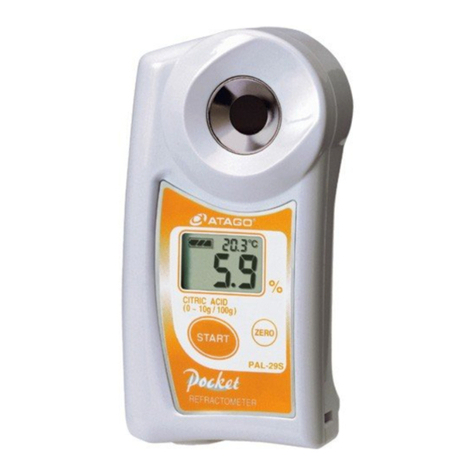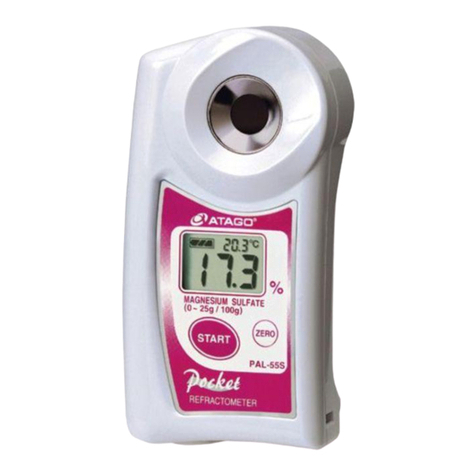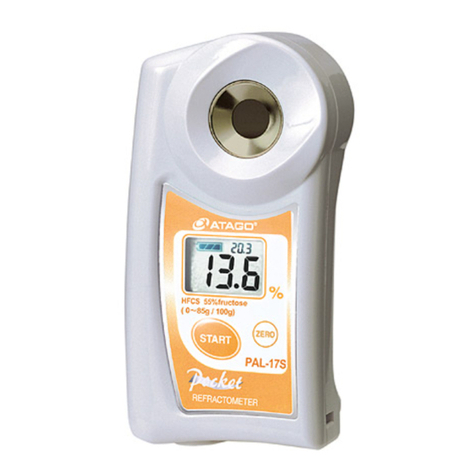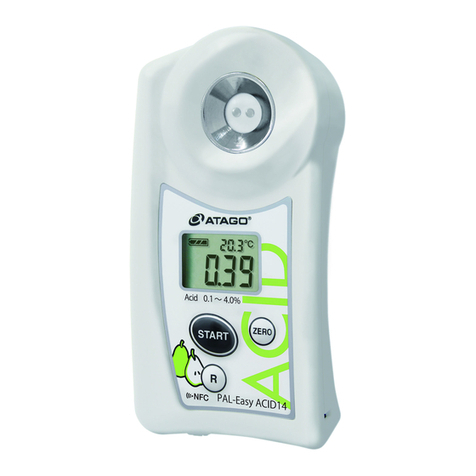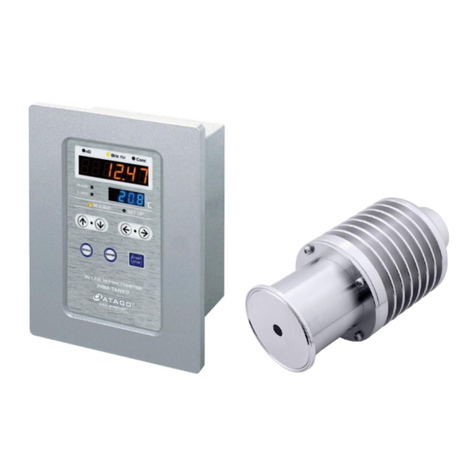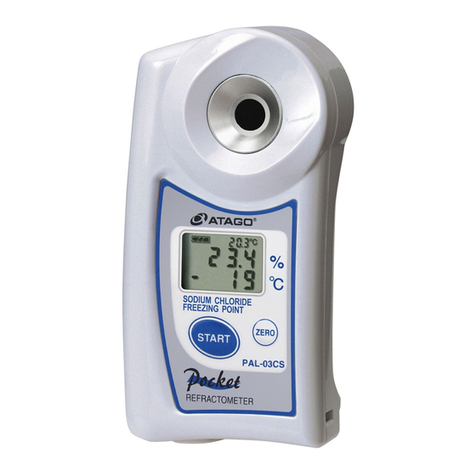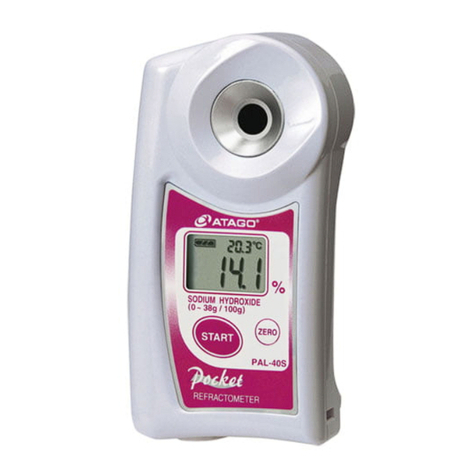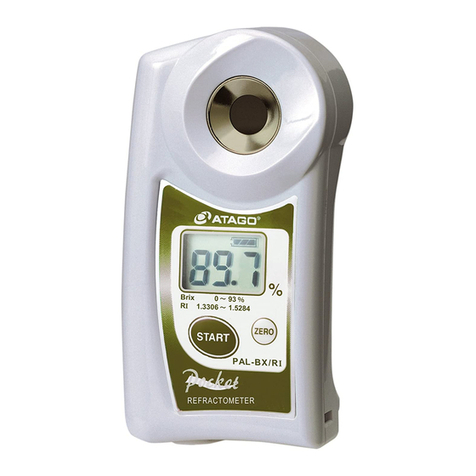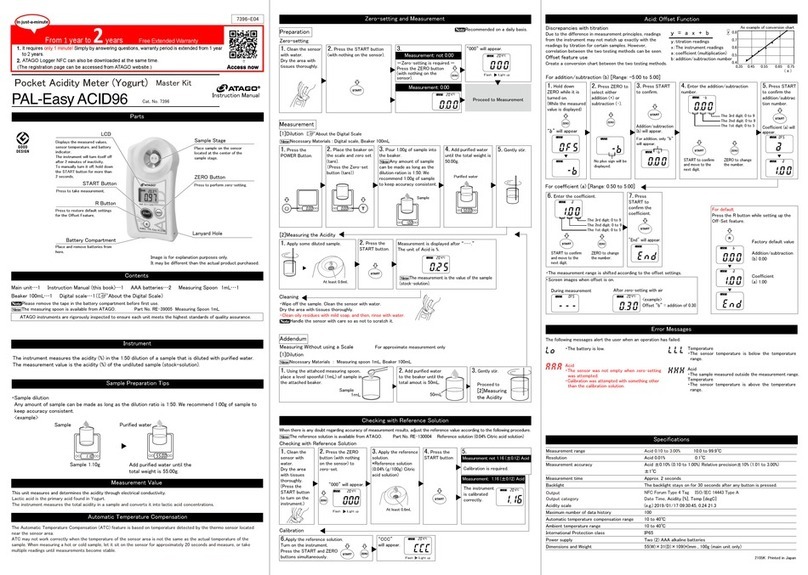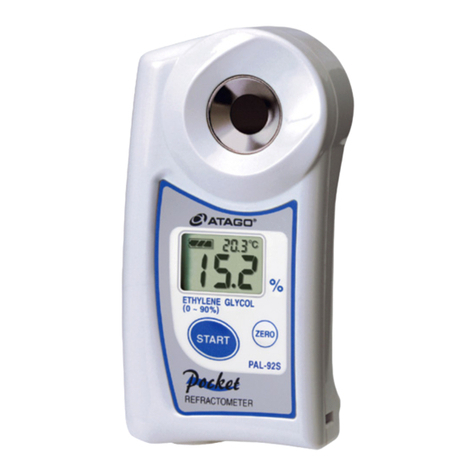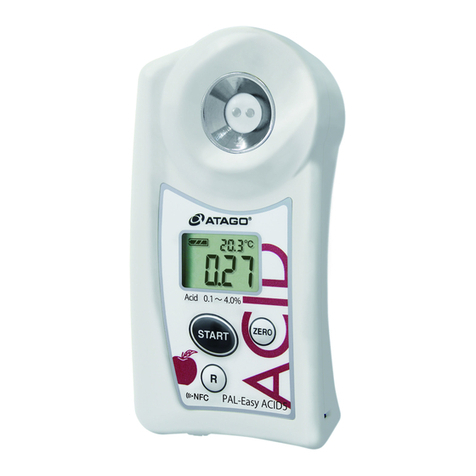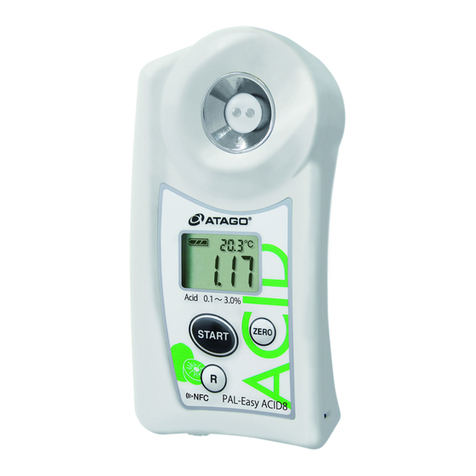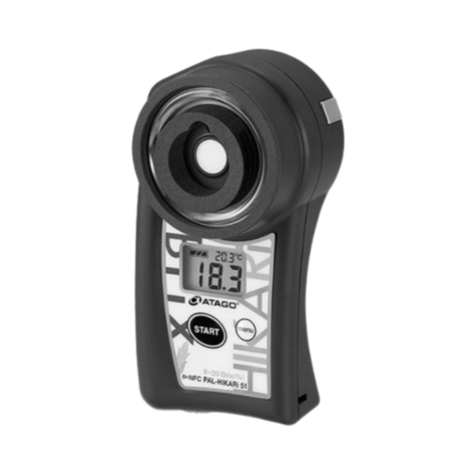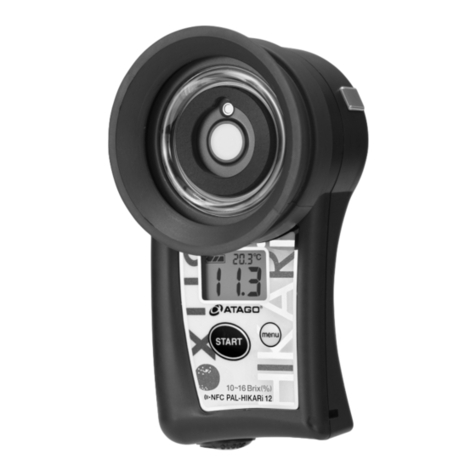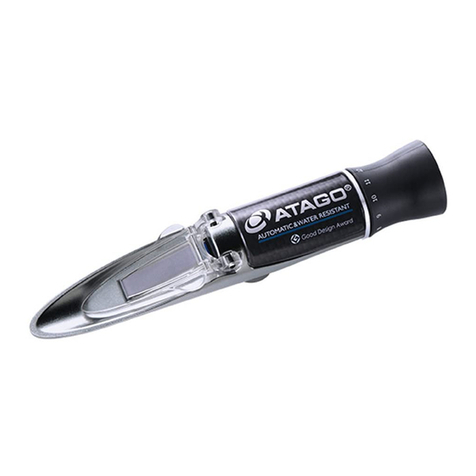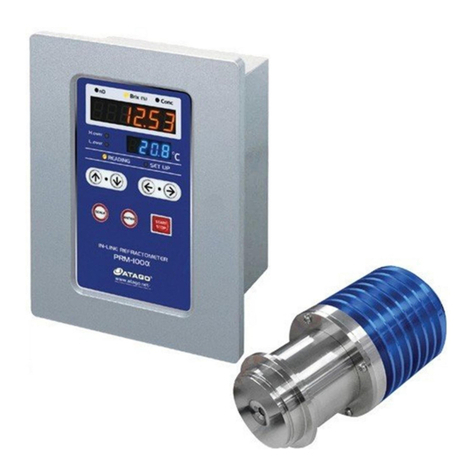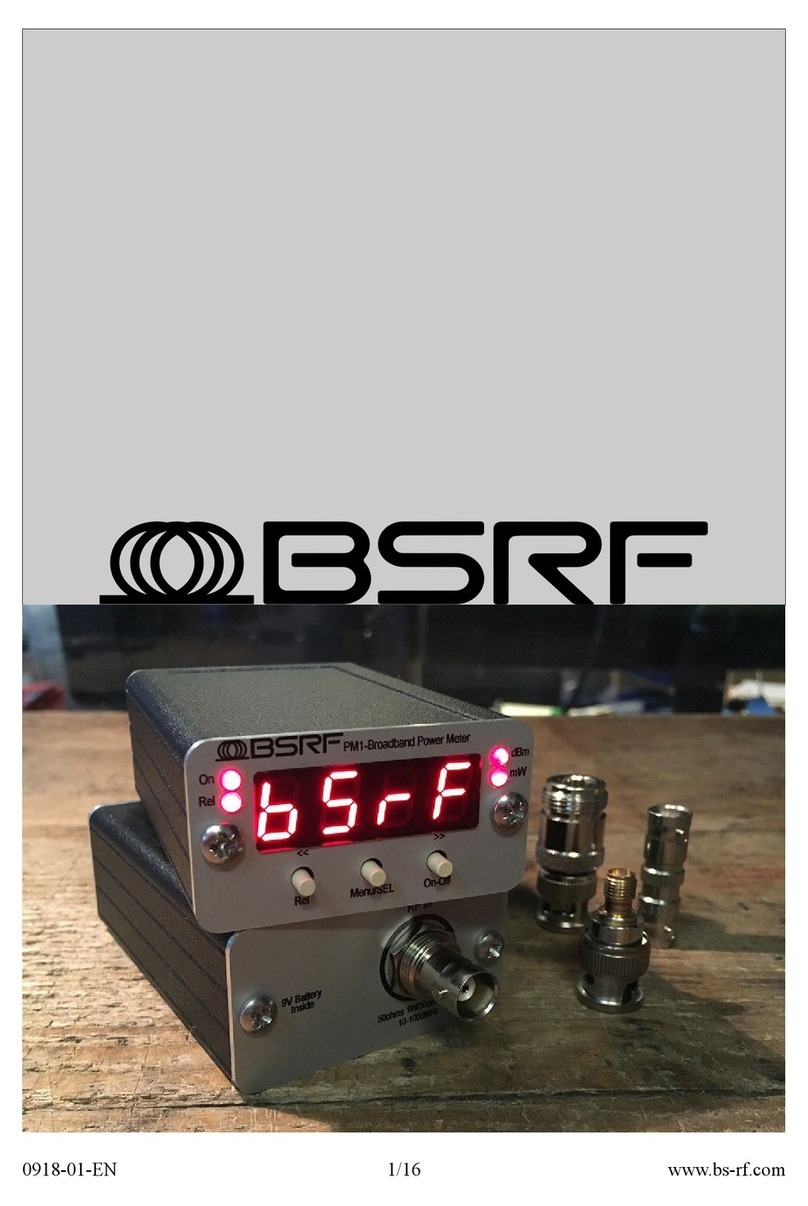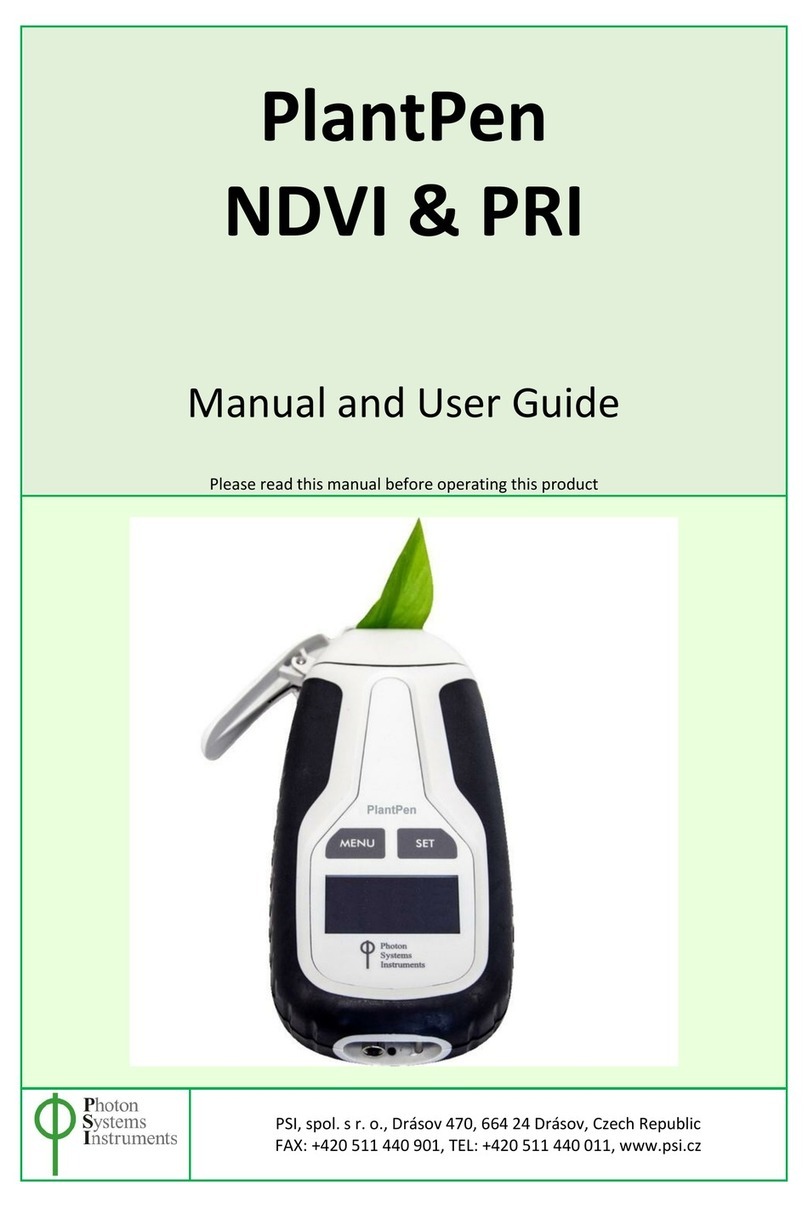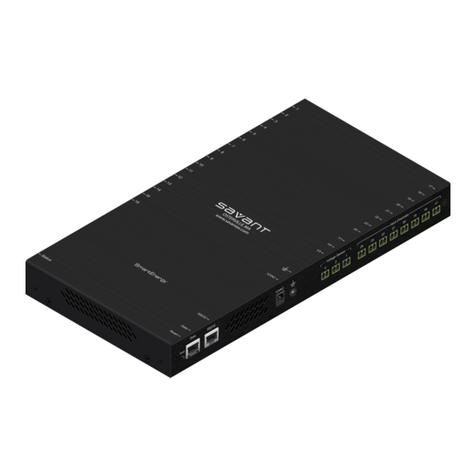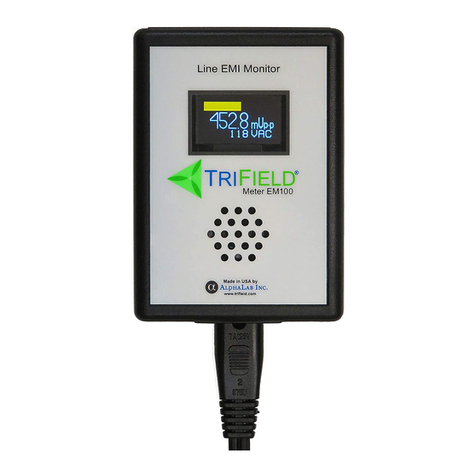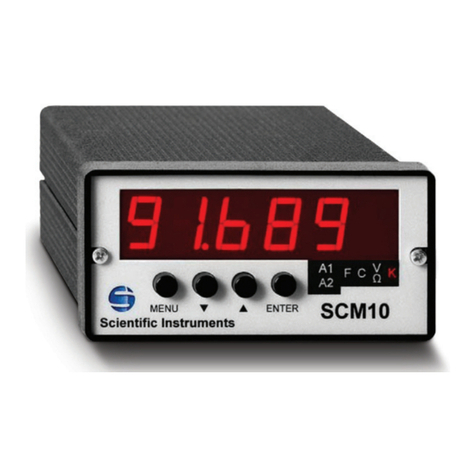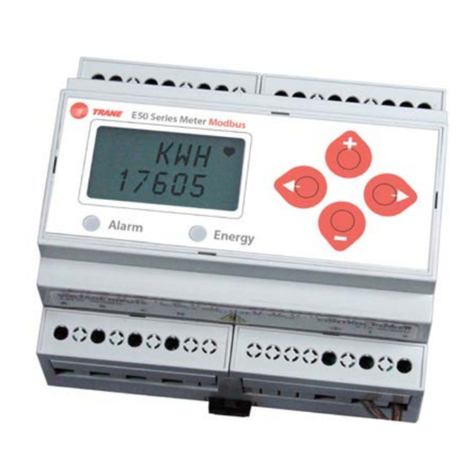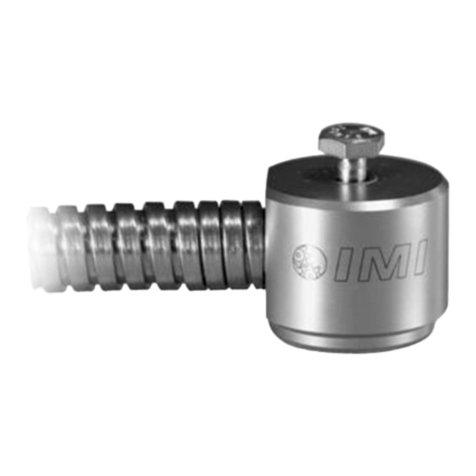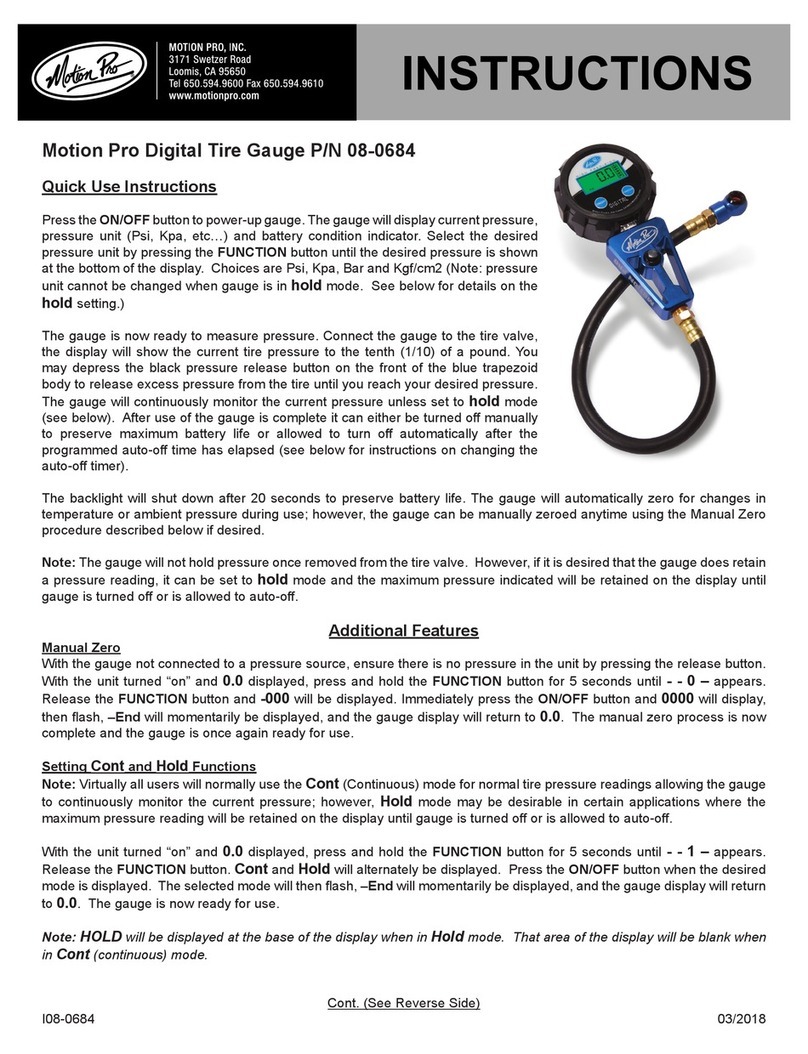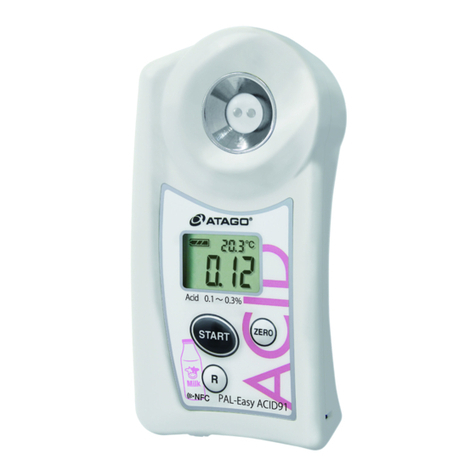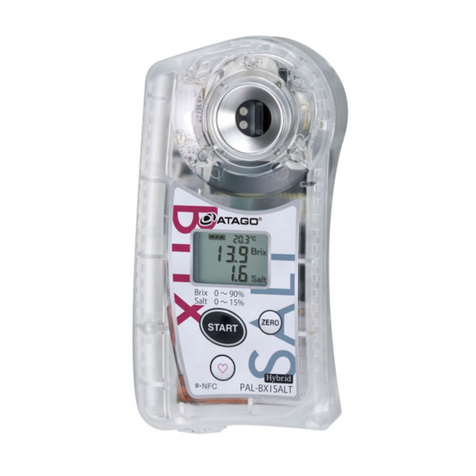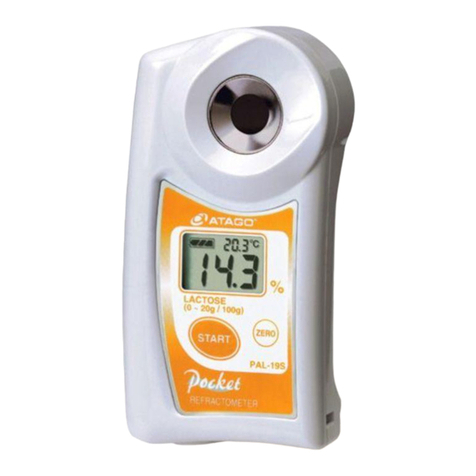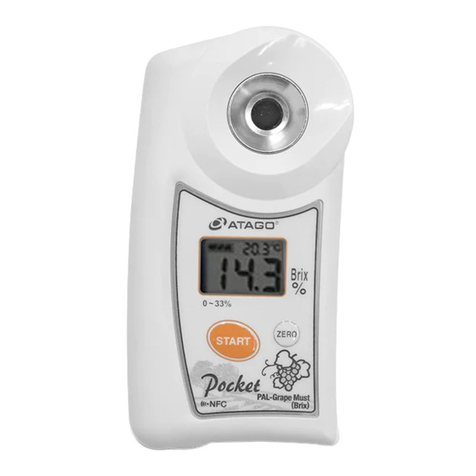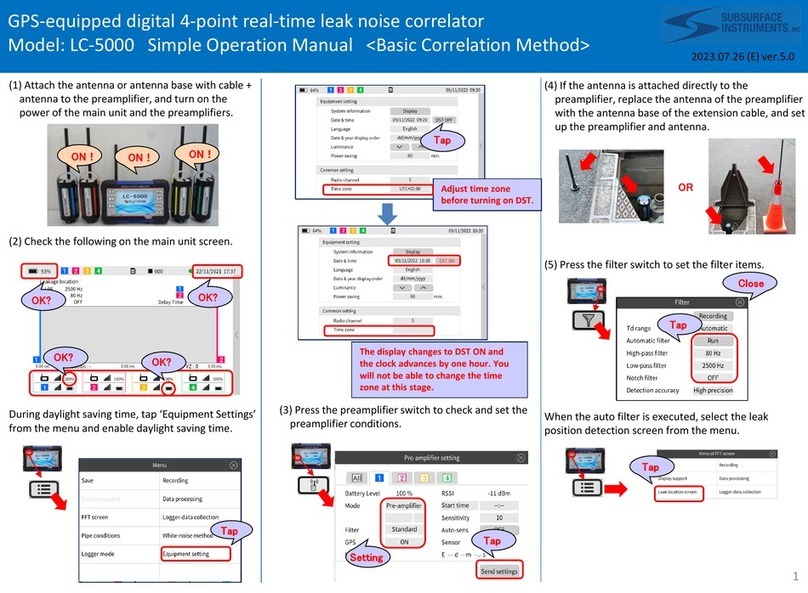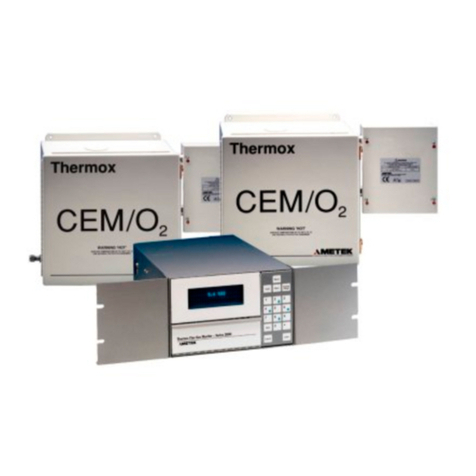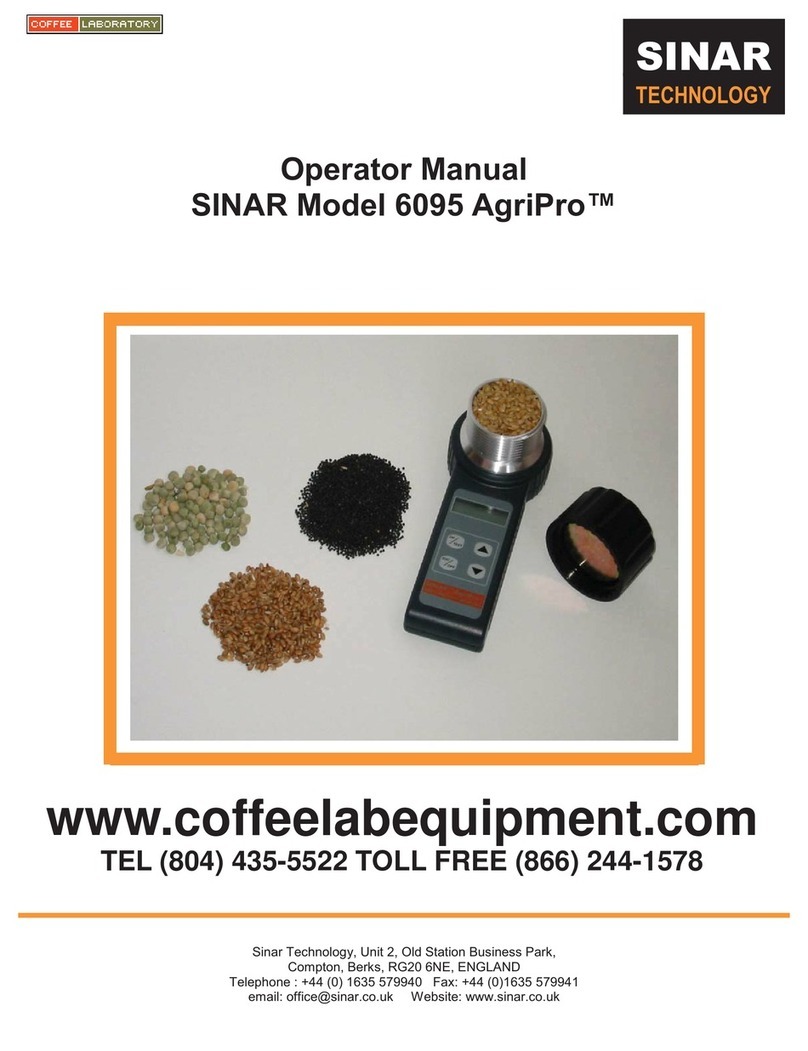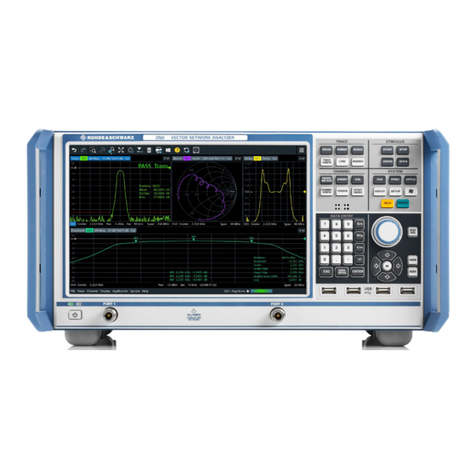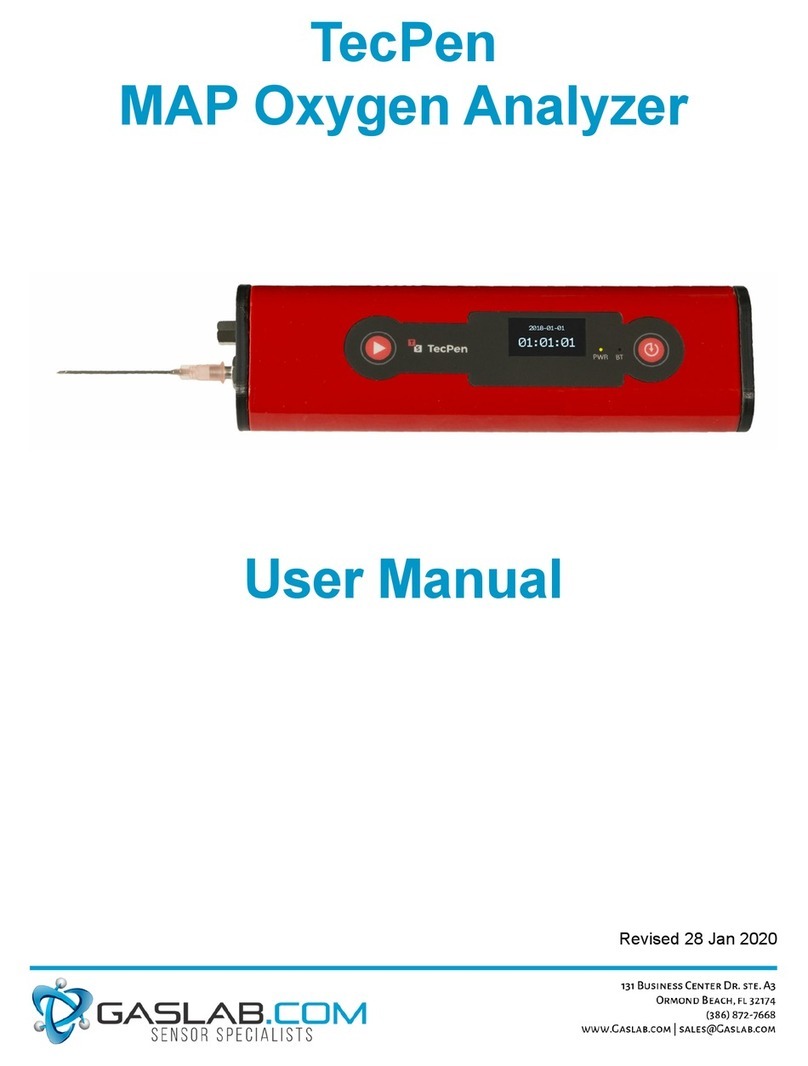
Headquarters: The Front Tower Shiba Koen,
23rd Floor 2-6-3 Shiba-koen, Minato-ku,
Tokyo 05-00 , Japan
http://www.atago.net/
TEL: -425-637-2 07
TEL: 9 -22-2854-49 5 / 407 -3232
TEL: 66-2 948727-9 ,66-2 7 549
TEL: 55 6 39 3-8400
TEL: 39 02 36557267
1709inted in Japan
Digital Hand-held “Pocket” Urine Osmolality Meter
PAL-mOsm. BLT/ i Cat. No. 4585i
4585i-E01
Instruction Manual
Parts
Introduction
FCC Complianc Stat m nt
The product is in conformity with the requirements of the EMC Directive 2004/ 08/EC and R&TTE Directive 999/5/EC.
Patent Granted in Japan, United States, Germany, China and Taiwan.
Press to take measurements and
hold down to turn off the display.
START button
Place and remove batteries from here.
Battery compartment
Sample stage
Apply water and samples
on the glass prism
located in the center of
the sample stage.
ZERO button
Press to perform
zero-setting. Press and
hold to export data via
Bluetooth.
Lanyard hole
Measurement results, prism
temperature, and remaining battery
charge are displayed.
The displayed value is an example.
LCD
Contents
Main unit....................................1
Instruction Manual .............. 1
(this book)
Calibration Report................. 1
AAA batteries .........................
AAA alkaline batteries are in-
cluded. Remove the tape from the
battery compartment before in-
serting the batteries..
Press to set the date and time. Be
sure to set the date and time
before intial use.
START button + ZERO button
- Increase the distance between the equipment and the receiver.
- Connect the equipment to outlet on a circuit different from that to which
- the receiver is connected.
- Consult the dealer or an experienced radio/TV technician for help.
FCC Caution: Any changes or modifications not expressly approved by the
party responsible for compliance could void the user’s authority to operate
this equipment.
Canada-Industry Canada
Operation is subject to the following two conditions: ( ) this device may
not cause interference, and (2) this device must accept any interference,
including interference that may cause undesired operation on this device.
To reduce potential radio interference to other users, the antenna type
and its gain should be so chosen that the equivalent isotropically radiated
power (EIRP) is not more than that required for successful communication.
Caution: Exposure to Radio Frequency Radiation.
To comply with RSS 02 RF exposure compliance requirements, for mobile
configurations, a separation distance of at least 20 cm must be maintained
between the antenna of this device and all persons. This device must not
be co-located or operating in conjunction with any other antenna or
transmitter.
MODEL: PAL-mOsm. BLT (CONTAINS FCC ID: P00-WC69)
USA-Federal Communication Commission (FCC)
This device complies with part 5 of the FCC rules. Operation
is
subject to the following two conditions:
( ) This
device
may
not
cause
harmful
interference, and (2) this device
must accept any interference received, including
interference
that
may
cause undesired operation.
INFORMATION TO USER:
This
equipment
has
been
tested
and found to comply with the limit for a
Class B digital device,
pursuant
to
Pat
5
of FCC Rules. These limits are
designed
to provide
reasonable
protection
against
harmful
interference
in a residential installation. This equipment generates, uses, and can ra-
diate
radio
frequency
energy. If not installed and used in accordance
with the instructions, it may cause harmful interference to radio commu-
nications.
However,
there
is
no guarantee that interference will
not
occur
in
a
particular
installation.
If
this
equipment
does
cause
harmful
interference to radio or television reception, which can be determined
by turning the equipment off and on, the user is encouraged to try and
correct the interference by one or more of the following measures:
- Reorient or relocate the receiving antenna
Some acids may corrode the glass prism and/or metal sample stage,
which may cause erroneous measurements.
Do not use metal tools, such as a spoon, as they may scratch the prism,
resulting in erroneous measurements.
Do not use water above 50℃ to rinse the instrument.
Only use the specified battery type. Observe proper polarities, properly
aligning the anodes and cathodes.
Store the instrument away from direct sunlight/heat sources and ex-
cessive amounts of dust/debris.
Do not expose the instrument to a rapid change in ambient temperature.
Do not subject the instrument to strong vibration.
Do not subject the instrument to extreme cold temperature.
Do not place the instrument under anything heavy.
Loosen the battery compartment cover for air transportation.
<International Protection Classification IP65>
The instrument is water-resistant, not waterproof, and should not be
submerged.
<Chemical Resistance of Body Case>
The body case is made of PBT resin. Do not expose it to water vapor.
Certain solvents may cause damage to the body case.
Thank you for purchasing the instrument. Carefully read and follow all
instructions. Keep this manual for future reference.
Safety Instructions
Read and follow all safety instructions before operating the instrument.
Failure to comply with the following instructions may result in personal
injury or property damage.
Ensure safety when handling hazardous materials. Observe precau-
tionary measures and use protective equipment, Be aware of the haz-
ards of such chemicals and emergency response guidelines.
ATAGO may not be held liable for any injury or damage arising in
connection with handling of hazardous materials during the use of the
instrument.
Do not drop the instrument or subject it to strong physical shock.
Do not attempt to repair, modify, or disassemble the instrument.
Carefully read this manual to have basic knowledge of the function of
each component.
ATAGO is not liable for any loss and damage caused by the meas-
urement and use of this instrument.
ATAGO instruments are rigorously
inspected to ensure each unit
meets the highest standards of
quality assurance.
Measurements may fluctuate with hot or cold samples. Wait for approximately 20 seconds
to press the START button.
Measurements will stabili e once the instrument acclimates to the sample temperature.
The readings are corrected, based on the
temperature of the prism, within the automatic
temperature compensation range.
Automatic temperature 10 to 40 ℃
compensation range
Ambient temperature range 10 to 40 ℃
Sample volume 0.3 mL or more
Measuring time 3 seconds
Power supply Si e AAA alkaline batteries × 2
Battery life Approx. 10,000 times measurement
(when an alkaline battery is used)
International Protection class IP65 Water resistant
Dimensions and weight 55 (W) x 31 (D) x 109 (H)mm,
100g (main unit only)
The Bluetooth® word mark and logos are registered trademarks owned by Bluetooth SIG, Inc.
iPhone, iTunes are trademarks of Apple Inc., registered in the U.S. and other countries.
App Store is service mark of Apple Inc.
Measurement range 0 to 1500 mOsmol/kgH
2
O
10.0 to 35.0℃
Resolution 10 mOsmol/kgH
2
O / 0.1℃
Accuracy ±20 mOsmol/kgH
2
O
See “Detailed explanation on Osmolality” / ±1℃
®
Output Bluetooth Ver 4.0
Maximum communication range: 3 to 7 m
Baudrate: 38.4 k/Data length: 8/Prity bit: none
RTS/CTS flow control/Stop bit: 1
Transmit data: time, data, Temp
Transmit data: 2014/05/30 15: 02: 21,1240,23.4,



